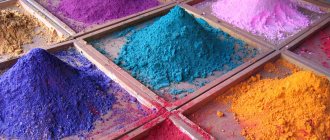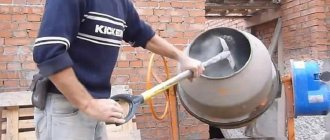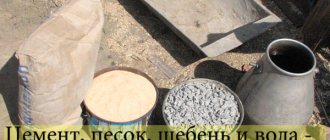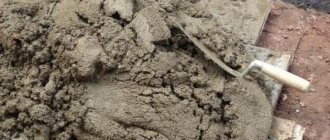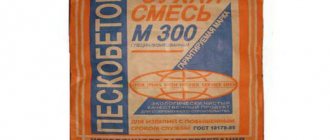Previously, on the pages of kamsaddeco.com, examples and methods of painting concrete have already been given (links at the end of the article), using both a certain mixture of pigments and their individual application.
Today, also using examples of some castings, we will consider the correspondence of the composition of the pigment mixture used and the production of a given color shade of artificial stone.
Let us note the influence of additives included in the cement mixture both on the color of concrete (especially light colors) and on its uniform distribution throughout the product.
Content
1. Once again about color and cement.
2. The basic composition of the cement mixture, additives that affect the color of concrete, and the form for artificial stone.
3. Mixture of pigments using examples.
4. Tips for DIYers.
Color and cement
In previous articles on concrete coloring, it was noted that to achieve light pastel colors, white cement must be used. To obtain dark colors of concrete, ordinary gray Portland cement is quite suitable.
The brand of cement is selected based on the ultimate goal of obtaining the required strength of concrete.
In the experiments conducted, both types of cement were used, both separately and in combination.
The mixture of pigments included not only iron oxide pigments, but also other dyes, which will also be discussed and recommendations for their use will be given.
Prerequisites for enamel color changes in children
- certain diseases (impaired normal functioning, performance)
of a pregnant woman: viral or bacterial lesions of the mother’s body, as well as certain medications (for example, tetracycline drugs) leave an imprint on the development of the fetus, including the formation of its tooth buds. This is fraught with the fact that the baby will erupt in units already with a deficiency (enamel hypoplasia or hyperplasia, tetracycline teeth, etc.),
- initial stage of caries: may change the color of milk crowns (snow-white spots appear on them),
- fluorosis: a surplus of fluoride in a child’s body (due to the huge consumption of fluoride-containing products, water, the use of paste with the highest content of this element) changes the color of the enamel, it becomes more grayish and at the same time rough, brittle, with grooves,
- healing with iron products: if they are consumed in a watery form, they cause temporary darkening of the tooth surface,
- constant consumption of coloring products: blueberries, bird cherry, sweets and drinks with artificial colors or based on burgundy and blue berries.
The basic composition of the cement mixture, additives that affect the color of concrete, and the form for artificial stone
To conduct experiments on the production of various colored artificial stones, the following ingredients were used: white cement M400, gray Portland cement M400, fly ash, fine quartz sand, colored cement grout, microsilica, individual dyes, a mixture of pigments, white carbon black, as well as various plasticizers, starting with regular Fairy and ending with hyperplasticizer.
The mold for casting the stones was the same as for the manufacture of decorative concrete tiles - from PVC plastic 0.7 mm thick. The mold was not lubricated with the separator (an advantage of this plastic), but was only washed before pouring again. This was due to the fact that it was not always possible to correctly calculate in advance the required amount of pigment in the cement mixture and that which was applied directly to the surface of the mold. Therefore, sometimes colored stains remained on the mold after the stone was removed. They had to be washed off with soapy water.
How to lay it?
To prepare a solution for decorative concrete and lay it, you need special skills, materials and tools. Read above about what cement should be used for this mixture. Before pouring, sand or crushed stone is placed on the working surface. Read here how to make decorative concrete with your own hands. You will also find information on how to apply it in site design.
Important! To prepare such a solution you will need special skills.
If the decorative concrete coating is poured, proceed to strengthening and painting it. At the first stage, apply a special multilayer base to the concrete layer (layer at least 10 mm), and the dyes used protect the resulting product or surface from ultraviolet radiation. Such a base may consist of granite and quartz sand. To increase color depth, use surface hardener and sealants. Construction stores sell ready-made mixtures of hardener, dye and ground quartz.
Important! To preserve the appearance of decorative concrete, its surface is treated every year with special waterproofing solutions.
What components of the cement mixture give additional color to concrete?
In the process of casting artificial stone with alternate replacement of various ingredients of the cement mixture (using only white cement), the following was revealed:
- Regular quartz sand gives concrete a beige tint.
- Shale ash gives concrete a yellow-beige hue.
- Microsilica (metakaolin MK-40) gives concrete a pink tint.
- In accordance with the color of the plasticizer used, the shade of the resulting stone also changes.
Conclusion: if you want to get a very light and delicate color, then you need to take into account these features of the components of the cement mixture. Moreover, the less water in the solution, the brighter the color of the stone.
"Subtleties" of manufacturing
Decorative cements get their color from the process of grinding white clinker, when dyes are added to the starting material, crushed to the appropriate state. The mummy makes it red, the umber turns it brown, ocher turns it yellow, chromium oxide turns it green, soot gives it a black tint, and ultramarine turns it blue.
If necessary, colored cement can be made with your own hands.
To do this, you must follow the following rules:
- the maximum concentration of the dye in the total mass of the mixture should not exceed 5%;
- do not overdo it with the amount of sand, which will dull the color and reduce the plasticity of the composition;
- The components must be mixed very thoroughly.
Mixture of pigments in colored concrete
Previously, articles have already given many examples of various handmade products made from colored concrete. Therefore, today only options with new castings will be considered.
Now a few words about dyes.
Inorganic pigments: iron oxides, cobalts, soot, ocher, white, red lead - are very stable, reliable, but do not have a pure color.
Organic pigments: on the contrary, give a bright, pure color, but are either unstable (in pastes), or affect the systems in some way, and also fade in concrete over several years.
Since we are faced with the task of using the simplest technologies available to DIYers, some unacceptable methods for professional craftsmen at home become quite applicable.
Previously, only iron oxide pigments were used in castings; today we will check other dyes.
Let's start with cobalt.
Task: obtain blue stones of varying intensities. Such stones, only much larger in size, were made and shown in an article about colored stone framing for a garden pool.
Today we get the same color, but in smaller castings.
Composition of concrete.
The first option is taken as a basis. Blue dye is added to the base mixture gradually increasing in quantity: 1 - 0.1 g, 2 - 0.3 g, 3 - 0.5 g, 4 - 1 g.
The counting of stones starts from the bottom left and goes clockwise. This is not difficult to guess from the set of color intensity.
This dye has a drawback - it is difficult to distribute evenly in the solution. To eliminate this, in the 4th option (where the maximum concentration) two more components were added that do not affect the color in any way: white soot (BS - 2 g or 2% of BC) and cellulose ether - 0.25 g (0.1 % of dry mixture).
Beige castings.
Two stones. The first version of the base mixture was used. Color additive - beige cement grout. Quantity: 10 g - stone on the left, 20 g - stone on the right.
Cement grout already contains chemical additives, so the color is distributed very evenly across the stone.
A similar, but less intense color can be obtained without grouting: you need to increase the amount of oil shale ash to 20...30 g. In addition, this will increase (if necessary) the strength of the product and reduce the amount of cement in the mixture.
Gray-orange casts.
Four stones. Iron oxide pigments: red (brick), yellow, green and brown. All pigments are made in Czech Republic.
To obtain the same color intensity, you need more of them than German pigments and less than Chinese pigments.
We must also remember that increasing the amount of pigment in the mixture reduces the strength of the artificial stone.
For all four stones, the first mixture was used.
Stone top right : added Kr. (0.5g).
Stone top left : added a mixture of pigments - Kr. (0.5 g.) + F (1 g.).
Stone bottom right : added pigments - Green. + Kr. + Cor. - all 0.5 g.
Stone bottom left : added pigments - Green. (2 years) + Kr. (2 years old).
Brown castings.
Four stones. Pigments: soot, red (brick), black, brown, blue, ruby.
The composition of the mixture for the stones in the photo, starting from the bottom left and then counterclockwise:
- 3rd base composition + Cor. (3 g) + Soot (0.5 g).
- 3rd basic composition + Kr. (2 years) + H (3 years).
- 1st basic composition + Cor. (3 g) + Blue (0.1 g).
- 1st base composition + Ruby (2 g.) + Cor. (1 year).
The ruby hardly showed up: the additives like the blue stone in the last version were not included.
Below, as an example, is an option for painting concrete using combined methods.
Stone top left: 1st base composition + Ruby (0.6 g).
Stone top right: 1st base composition without pigments. Dry ash and separately green grout are randomly applied to the mold.
Stone bottom left: 3rd basic composition + Ch (1 g) + F (1 g) + Blue (0.5 g). Mica and a little black pigment are applied to the mold.
Stone bottom right: 1st base composition + Cor. (1 g.) + black concrete chips.
The solution is poured gradually in small portions. Until the crumb is covered with the solution, press it and vibrate the mixture.
Dyes for brickwork
The masonry mortar can also be given the desired color, which is achieved by introducing pigments. There are many dyes for masonry on sale - Precolor, YIPIN, Perel, Fepren and others. Shades of the same color vary greatly from one manufacturer to another, so you should choose them according to your individual needs. It is extremely undesirable to use pigments of different brands on the same masonry - this can spoil the overall appearance of the building, because the color of the seams will not be the same.
Types of dyes for brickwork mortar
All described types of pigments, as well as dyes created on their basis - acrylic, acid and others, are suitable for this purpose. They color lime, cement, cement-lime mortars. The proportion of paint in the total mass should not exceed 8%, otherwise the strength of the brickwork will decrease.
Choice - what to look for
The most important indicator is the color of the pigment. With its help, you can highlight the seams or, on the contrary, make them invisible (if you use dye to match the brick). The pigment should strengthen the structure and make the solution more resistant to the sun, water, and temperature changes.
Also, when selecting dyes, their moisture retention rate is taken into account:
- low – 5-6% (for clinker bricks),
- average – 7-10% (for facing bricks),
- high – 10-15% (for sand-lime brick).
Taking into account such parameters, it is possible to reduce the risk of pigment discoloration and the appearance of efflorescence spots on the surface of the seams. Most often, shades of pigments such as brown, yellow, pink, beige, and white are used for brickwork. Although you can use any other color.
Preparation and use of the solution
To make lime mortar, mix 1 part fine lime, 2 parts sand and a sufficient amount of water. The cement-lime mortar includes cement and lime milk, as well as sand (1 part each of lime, cement and 4-6 parts of sand).
First, mix the dry ingredients, then pour in water so that the consistency is like soft butter (the amount of water can be determined by eye). Afterwards, pigment or liquid dye is added to the prepared masonry solution. It is better to use a concrete mixer for mixing. A small volume of components can be mixed manually, using a spatula, in a bucket or other container.
The classic color is white; it is obtained by adding slaked lime, zinc oxide or titanium oxide. The last option is the most expensive, but it ensures longevity of the shade for decades. To reduce costs, the entire masonry is often filled with ordinary, gray mortar, and colored mortar is placed only along the edges that will be visible.
Innovations in the use of colored masonry mortars
Manipulating the color of brickwork or individual walls or sections of the wall will help create unusual housing design options. A universal way to highlight masonry is to use contrasting shades. White seams will look especially bright in combination with any brick tone except yellow.
Also, colored solutions can mask masonry seams and completely hide the structure of the wall. To do this, pigments are added to give the solution an absolute similarity to the tone of the brick itself. When cleaning the seams, they are well aligned so that they follow the texture of the base material. You can, on the contrary, not give the wall a monolithic appearance, but make an extruded pattern. To do this, blocks of bricks are laid in a special way.
Experts also use the following new techniques to create spectacular brickwork:
- adding finely ground glass fluorescent powder to the solution to glow the seams against the background of dark brick,
- introduction of pigments that change color depending on the ambient temperature.
When choosing dyes, you need to ensure their suitability for the purpose of tinting the solution. Unscrupulous manufacturers replace non-ferrous metal salts with aniline dyes, which wash out and fade literally within a season. Only real pigments will provide a beautiful appearance to buildings and will serve for a long time - do not skimp on quality!
About the powerful in spirit
Business card
Alexander Kott was born in 1973 in Moscow. Twin brother of film director Vladimir Kott. He graduated from the school of aesthetic education at the Theater on Krasnovataya Presnya and worked as a photographer. In 1994, he entered VGIK, Vladimir Khotinenko’s feature film directing workshop. In 1997, commissioned by French television (ARTE channel), he shot the one-shot film “The Journey” and the short film “Rope” (1998). After graduating from VGIK, he directed the full-length film “Two Drivers Were Moving” (2001). Then there was a multi-part television film based on the novel by Valentin Pikul “Convoy PQ-17” (2004) and “Brest Fortress” (2010), an 8-episode television film “Diamond Hunters”. In November 2012, the 16-episode film “The Far Side of the Moon” (an adaptation of the BBC television series “Life on Mars”) was released. In 2014, Alexander Kott’s film “Test” received the main prize at the Kinotavr festival.
vote
Article rating
